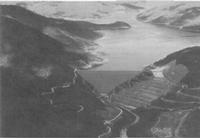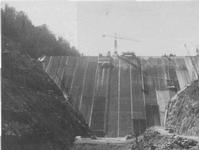


Chapter 6
I Construction During The Settlement Years
II The Use Of Timber As A Structural Material
III Structural Steel
IV Concrete Technology
V Housing
VI Industrialised Pre-cast Concrete Housing
VII Ports And Harbours
VIII Roads
IX Heavy Foundations
X Bridges
XI Sewerage
XII Water Engineering
i Pipelines
ii Tunnels
iii Dams
iv Power Stations
XIII Railways
XIV Major Buildings
XV Airports
XVI Thermal Power Stations
XVII Materials Handling
XVIII Oil Industry
XIX The Snowy Mountains Scheme
XX The Sydney Opera House
XXI The Sydney Harbour Bridge
XXII Hamersley Iron
XXIII North West Shelf
Sources and References
Index
Search
Help
Contact us

Dams
Many of the early dams in Australia were of concrete. This was because the economics of earth-moving as an alternative were unfavourable at the time and because the technology of earth and rock-fill embankments was not properly understood. When earth dams were built they usually relied on a core wall of concrete or timber for their watertightness.Concrete dams of the arch type require narrow valleys and sound foundations. These conditions are seldom found in Australia, so arch dams are not very common. Some notable arch dams have, however, been built, including Tumut Pond Dam (86 m high) in the Snowy Mountains and the Gordon Dam (140 m high) in Tasmania.
A series of four gravity-type concrete dams were built in the upper Nepean catchment near Sydney, commencing with the Cataract Dam in 1907. These dams were of the cyclopean masonry type, that is, large blocks of rock were embedded in the concrete in order to economise in the use of cement. The largest concrete gravity dam in Australia is the Warragamba Dam near Sydney, with a height of 137 m and a total volume of concrete of 1,242,000 m3. The Burdekin Falls Dam in Queensland was begun in 1984 and will contain about 620,000 m3 of concrete.
A further recent development in dam building is to use low cement content gravels known as rollcrete and to place and compact this material with earth-moving plants in thin layers without joints. A dam of this type was recently completed at Copper-lode Falls in Queensland.
Earth and rockfill dams have become more popular since 1945, thanks to the development of large earth-moving equipment. The Eucumbene Dam (116 m high) in the Snowy Mountains was completed in 1958. Since then there have been the Talbingo Dam (162 m high) in 1972, Dartmouth Dam (180 m high) in 1979 (Fig. 41), and Thompson Dam (165 m high) in 1983. These dams are among the highest earth core, rockfill dams in the world.

Another type of dam which has gained much popularity in Australia and elsewhere in recent years is the concrete-faced, rock-fill dam. The successful development of this type of dam owes much to the experience of the Hydro Electric Commission of Tasmania (HEC) (Fig. 42). In 1966 no completely successful concrete-faced dam over 80 m high was in operation in the world and the HEC set out to determine the design and construction practices required to minimise the leakage problems which had been experienced in previous dams of this type. The Cethana Dam (110 m high) completed in 1971 was highly successful, with a total leakage of only 35 litres/s.

Organisations in Australian Science at Work - Hydro Electric Commission of Tasmania
People in Bright Sparcs - Price, Douglas G.
 |
Australian Academy of Technological Sciences and Engineering |  |
© 1988 Print Edition pages 371 - 372, Online Edition 2000
Published by Australian Science and Technology Heritage Centre, using the Web Academic Resource Publisher
http://www.austehc.unimelb.edu.au/tia/371.html